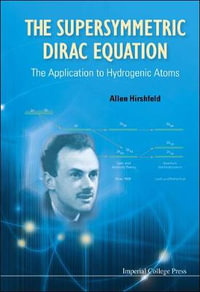This book is a rigorous, unified account of the fundamental principles of the density-functional theory of the electronic structure of matter and its applications to atoms and molecules. Containing a detailed discussion of the chemical potential and its derivatives, it provides an understanding of the concepts of electronegativity, hardness and softness, and chemical reactivity. Both the Hohenberg-Kohn-Sham and the Levy-Lieb derivations of the basic theorems are presented, and extensive references to the literature are included. Two introductory chapters and several appendices provide all the background material necessary beyond a knowledge of elementary quantum theory. The book is intended for physicists, chemists, and advanced students in chemistry.
Industry Reviews
"The theory of atoms, molecules and solids is largely dependent on good approximate solutions to appropriate quantum mechanical many-electron systems. Thus the appearance in recent years, of a new practical way to generate such solutions has met with considerable interest. The method is the density-functional method (DFT) in the local density approximation (LDA). . . . R.G. Parr and W. Yang are experienced professionals in this area . . . Their book is a
thorough and solid introduction to the DFT. . . . I found the book well written, accurate and helpful. I recommend it." --Annual Nuclear Energy
"Gives an excellent summary of the foundations and, much more briefly, of some of the applications of this electron density theory . . . . well written and important book." --The Times Higher Education Supplement
"The author's goal of giving 'a coherent account of the (density-functional) theory as it stands today' has been attained in this excellent book." --Theoretica Chimica Acta
"This book is an excellent rigorous introduction to the ideas of density functional theory, couched in the language of density matrices that is familiar to theoretical chemists. It is well-written and authoritative, fills a void in the literature, and should be part of the library of practicing theoretical chemists and physicists." --Journal of the American Chemical Society
"In the book, Parr summarizes, in a rigorous and fairly mathematical way, the basic theorems related to the density-functional method. Much emphasis is placed on a thorough review of the work done by his own students.. . . Basic principles are emphasized and explained in elegant mathematical detail. Various approximations of the exchange and correlation potential are carefully examined. The book provides the essential perspective and background needed by an
investigator who wants to continue to progress in the field." --American Scientist
"The theory of atoms, molecules and solids is largely dependent on good approximate solutions to appropriate quantum mechanical many-electron systems. Thus the appearance in recent years, of a new practical way to generate such solutions has met with considerable interest. The method is the density-functional method (DFT) in the local density approximation (LDA). . . . R.G. Parr and W. Yang are experienced professionals in this area . . . Their book is a
thorough and solid introduction to the DFT. . . . I found the book well written, accurate and helpful. I recommend it." --Annual Nuclear Energy
"Gives an excellent summary of the foundations and, much more briefly, of some of the applications of this electron density theory . . . . well written and important book." --The Times Higher Education Supplement
"The author's goal of giving 'a coherent account of the (density-functional) theory as it stands today' has been attained in this excellent book." --Theoretica Chimica Acta
"This book is an excellent rigorous introduction to the ideas of density functional theory, couched in the language of density matrices that is familiar to theoretical chemists. It is well-written and authoritative, fills a void in the literature, and should be part of the library of practicing theoretical chemists and physicists." --Journal of the American Chemical Society
"In the book, Parr summarizes, in a rigorous and fairly mathematical way, the basic theorems related to the density-functional method. Much emphasis is placed on a thorough review of the work done by his own students.. . . Basic principles are emphasized and explained in elegant mathematical detail. Various approximations of the exchange and correlation potential are carefully examined. The book provides the essential perspective and background needed by an
investigator who wants to continue to progress in the field." --American Scientist
























